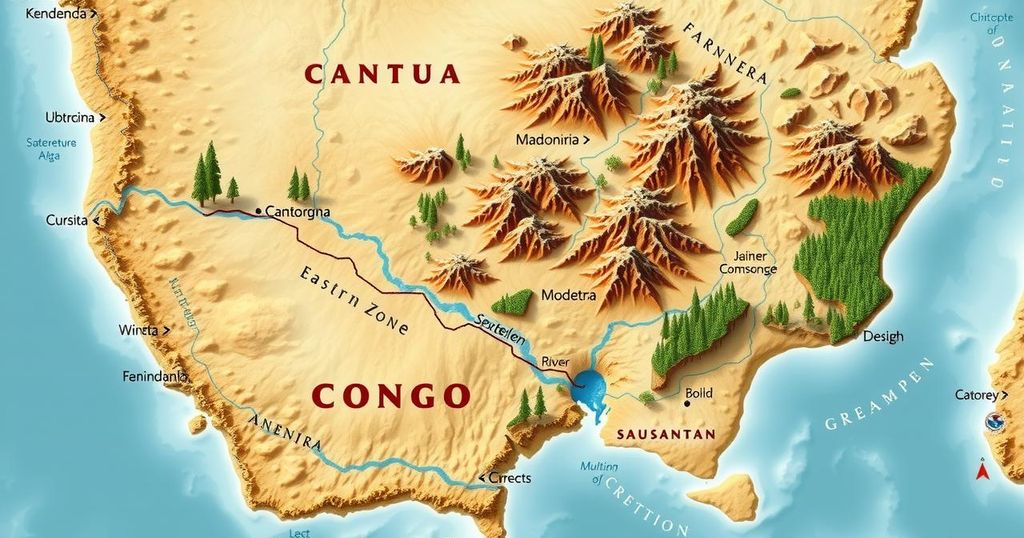Global news
AFRICA, AFRICA PROGRAM, BUKAVU, CENTER FOR STRATEGIC AND INTERNATIONAL STUDIES, CFR, CIVIL WAR, CONGO, CONGO (KINSHASA), DEMOCRATIC FORCES FOR THE LIBERATION OF RWANDA, DEMOCRATIC REPUBLIC OF THE CONGO, FDLR, HUMAN RIGHTS, HUMANITARIAN, JAMES M. LINDSAY, JIM, MILITARY, MVEMBA, MVEMBA DIZOLELE MVEMBA DIZOLELE, MVEMBA PHEZO DIZOLELE, RWANDA, SECURITY
Leila Ramsay
0 Comments
Renewed Conflict in Eastern Congo: Insights and Implications
The conflict in eastern Congo has been rejuvenated by the M23 rebel group, supported by Rwanda, leading to a humanitarian crisis. The combatants have seized key cities, causing widespread displacement and fatalities. Financial motivations tied to regional mineral wealth complicate the situation. Political resolution remains unlikely due to ineffective governance and regional divisions.
The resurgence of the Rwanda-backed M23 rebel group has intensified the long-standing conflict in eastern Congo, characterized by ethnic rivalries, mineral wealth interests, and political representation. Mvemba Phezo Dizolele, a senior fellow at the Center for Strategic and International Studies, discussed these issues on a recent episode of “The President’s Inbox.”
In recent developments, the M23 group has successfully captured the cities of Goma and Bukavu, leading to a severe humanitarian crisis. Rwanda’s ethnic Tutsi-majority government has been implicated in arming and financing the M23, with approximately 3,000 to 4,000 Rwandan troops engaging in combat against the Democratic Republic of the Congo’s government forces, as well as opposing the FDLR, a Hutu group linked to the 1994 genocide. Mvemba outlined that, “About two million Hutu Rwandans fled into Congo after the genocide, among them the entire Rwandan army with its arsenal,” underlining the historical context of the ongoing conflict. The toll of this latest round of fighting has been devastating, with 7,000 lives lost and over 600,000 individuals displaced, raising alarms of impending famine for millions more.
Beyond ethnic issues, financial motives are deeply intertwined with the conflict. The M23 originated as a response to perceived governmental Collusion with the FDLR while seeking to assert minority Tutsi rights. The region’s vast mineral resources, including cobalt and coltan, are pivotal to the global economy, particularly in electronics. Mvemba noted the existence of a “war economy on both sides of the border,” highlighting Rwanda’s purported resource exploitation. Notably, the European Union is reassessing a mineral trade agreement with Rwanda amidst allegations of illicit resource extraction from eastern Congo, while China’s influence in the local mining sector is noted for employing bribes and military technology to fortify the Congolese government’s military efforts against M23.
The possibility of resolving the conflict through political negotiations or military action appears grim. The Congolese government has historically failed to address its internal challenges and has discarded past initiatives aimed at refugee reintegration and reform. The United Nations peacekeeping forces have struggled to contain the M23 resurgence, and divisions among regional bodies further complicate mediation. Mvemba remarked that, “The M23 is primarily seen as a Tutsi group, Rwanda-backed… and they have no allies inside Congo to help them this time.” With over a hundred armed factions operating in eastern Congo, and insufficient intervention from global powers, a lasting resolution remains elusive.
The conflict in eastern Congo has escalated significantly due to the M23 insurgency, exacerbated by the geopolitical dynamics involving Rwanda and local militia groups. The intertwined issues of ethnic rivalry, resource exploitation, and weak governance hinder any foreseeable resolution. Given these challenges, the future of peace and stability in the region remains uncertain.
Original Source: www.cfr.org




Post Comment